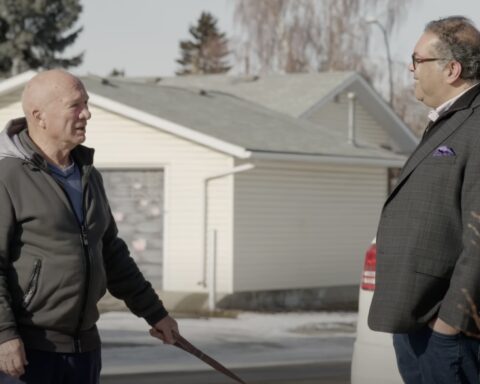For some, Alberta’s history is just about cowboys, oil, and Conservatives, but a new television series is shedding light on the many contributions that minority groups have made in the province.
An Omni TV magazine-style series, “Alberta Roots”, goes under the surface to tell the stories of immigrant communities and their contributions to the wild rose province, since the time of their early settlement to the present.
For example, members of Calgary’s Jewish community gave the city its iconic white hat, the +15 Skywalk bridge system and the Jack Singer Hall Centre.
Gingi Baki, the executive producer of the show, says immigrants with their kind spirit have defined Alberta since its beginning – defying the intolerant redneck stereotype many hold of the province.
“Generosity is a common theme among all immigrants,” said Baki, who adds that throughout Alberta’s history when immigrants did well, they also helped others in their communities.
“Generosity is a common theme among all immigrants.”
The province’s first pioneers were from Great Britain, the U.S., Germany, Ukraine, Scandinavia and other parts of Europe.
Among the first immigrants to come to Alberta from the U.S. were black farmers who were denied equal rights in Oklahoma. Many Chinese workers made Calgary home as well after the national railway was built.
“There have been small pockets of immigrants through all our history,” says Baki.
Many immigrants have also come to Alberta because of the good economic times – from the gold rush to the first oil booms. However, many of them stayed after because of the beauty of the province, Baki suggests.
“The openness, the skies and the sunsets stay in your soul.”
Facing racism in the pioneer years
Kirk Niergarth, a professor of Canadian history at Mount Royal University in Calgary, says it was hard for minority groups to settle in Alberta right up to the early 20th century.
In 1911, a white teenager, Hazel Huff, lost her mother’s diamond ring and blamed it on a “big, black, burly nigger”* who broke into her home and assaulted her.
Media hysteria broke in Edmonton, and her assault was blamed on black people immigrating to the province, according to historical archives.
When Huff later told the truth, it was too late. “The damage was already done,” says Niergarth.
“The waves of immigration created anxiety of the unknown.”
In 1892, a Chinese man fell ill with smallpox in Calgary. To contain the disease, city officials burned the laundry where he lived, and put all of its occupants under armed quarantine.
A mob of 300 people tried to run the quarantined individuals out of Calgary when they were released – and the RCMP had to control the situation.
Niergarth explains that Alberta – like the rest of Canada – felt troubled by the changes newcomers were bringing to society.
“The waves of immigration created anxiety of the unknown.”
Alberta’s changing fabric
It is not a secret that Alberta is growing rapidly. Part of this growth is that more minorities are moving into the province.
According to Statistics Canada census data, the growth of Alberta visible minorities has skyrocketed. In 1991, visible minorities made 9.4 per cent of Alberta’s population. As of 2011, they represented 18.4 per cent.
Of those visible minorities, a 2008 report shows 91 per cent settled in the major cities – Calgary and Edmonton. But that also appears to be changing.
Presently, the city of Lethbridge attracts many visible minorities thanks to its low cost of living and good job market. The city is home to the biggest Bhutanese community in Canada.
Surya Acharya, an agricultural research scientist and immigrant from India, moved to Lethbridge from Edmonton in 1989. His friends told him that he was moving into “redneck country.” They said he wouldn’t survive too long in the small southern Alberta city.
It has been almost 30 years, and Acharya says he has been comfortable in Lethbridge since he arrived.
“They were wrong,” he adds.
Today, he is the president of the Southern Alberta Ethnic Association, where 32 different ethnic groups from four different continents are represented.
“People only care that you work hard – it doesn’t matter your colour or religion.”
Acharya says things have changed extensively since he moved into Lethbridge. “It is more common these days to see visible minorities in Southern Alberta.”
Acharya says the reason why there aren’t more visible minorities in rural Alberta isn’t because of intolerance, but lack of resources and entertainment opportunities.
“Jobs only keep them busy for 40 hours,” he says.
Alberta’s immigrant spirit
Acharya says that the redneck stereotype is untrue in modern Alberta. For him the pioneer immigrant spirit is what represents the province.
“It doesn’t matter where you came from, people only care that you work hard – it doesn’t matter your colour or religion,” he shares.
Niergarth says the stereotype of Alberta being a redneck province comes from the interpretation of its culture and politics in other parts of Canada.
Things like the Calgary Stampede and the platform of the Reform party were associated with the redneck image, he explains.
However, these views of Alberta aren’t always accurate. “It is not based in research, so proceed with caution,” Niergarth says.
If Alberta was really intolerant there would be no immigrants in the province, he adds.
“Maybe the proof is in the dough.”
“Alberta Roots” is being aired on Omni TV in Alberta and British Columbia. In the future it will be aired in Ontario, and it will be available on the Omni website.
*Editor’s Note: “The racial slur, albeit disquieting, was quoted precisely from a historical context to establish the type of mentality that existed among some people.”





What town or village has the least non European immigrants